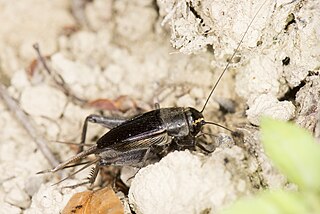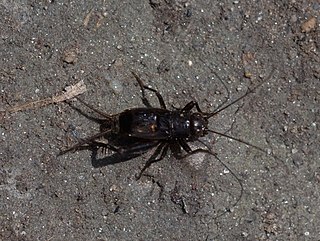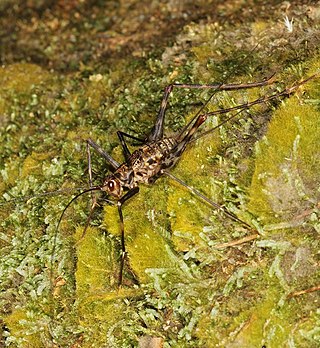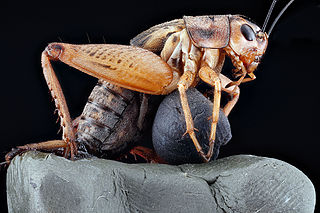
Myrmecophilus or ant crickets, is a genus of orthopteran insects in the family Myrmecophilidae. This genus contains the majority of myrmecophilous (ant-loving) species in this small, obscure family.

Conocephalus is a genus of bush crickets, known as coneheads. It was described by Carl Peter Thunberg in 1815.

Trigonidiinae is a subfamily of insects in the order Orthoptera, suborder Ensifera, based on the type genus Trigonidium. They are often referred to as sword-tail crickets, winged bush crickets or trigs.

Teleogryllus is a genus of crickets in the family Gryllidae. Species can be found in Africa, Asia, Australia and the Pacific islands.

Mogoplistidae is a family of scaly crickets within the superfamily Grylloidea. Considered to be monophyletic, a sister taxon to the Gryllidae crickets. This family consists of more than 370 species worldwide; 20 species in 4 genera occur in North America and this family includes the scaly crickets of Europe.

Gymnogryllus is a genus of crickets in family Gryllidae and tribe Gryllini. Species are recorded from Africa, Asia and Australia.

Homoeogryllus is a genus of cricket in the subfamily Cachoplistinae and tribe Homoeogryllini. The recorded distribution is: Africa and Peninsular Malaysia.
The Pteroplistinae comprise a subfamily of crickets, in the superfamily Grylloidea. Species are found in tropical Asia.

Pteronemobius is a genus of crickets in the subfamily Nemobiinae, with a worldwide distribution.

The Phalangopsidae are a recently reconstituted family of crickets, based on the type genus PhalangopsisServille, 1831 from South America. Priority for family-group names based on this genus dates from Blanchard's "Phalangopsites".
The Euscyrtinae are a subfamily of crickets, in the family Gryllidae, based on the type genus Euscyrtus. They are terrestrial and omnivorous and can be found in: Central America, Africa, Asia and Australia.

Gryllini is a tribe of crickets and typical of the family Gryllidae. Species are terrestrial, carnivorous or omnivorous and can be found in all continenents except Antarctica.

Velarifictorus is a genus of crickets in the family Gryllidae and tribe Gryllini. Species have been recorded in Australia, Asia, Africa and the southeastern US.

Truljalia is a genus of crickets in the subfamily Podoscirtinae and tribe Podoscirtini. Species have been recorded in: India, southern China, Korea, Japan, Indo-China and west Malesia.
Aphonoides is a genus of crickets in the subfamily Podoscirtinae and tribe Aphonoidini. Most species records are from eastern Asia and Australasia, but some have been found in Africa and South America.
Sonotrella is a genus of crickets in the subfamily Podoscirtinae and tribe Podoscirtini. Species have been recorded in: southern China, Indo-China and west Malesia.
Duolandrevus is a genus of crickets in the subfamily Landrevinae and tribe Landrevini. Species can be found in Asia.
Patiscus is a genus of crickets in the subfamily Euscyrtinae. Species can be found in Asia, with records from India, China, Indo-China, the Philippines and New Guinea.

Ornebius is a genus of crickets in the family Mogoplistidae and the tribe Arachnocephalini, erected by Félix Édouard Guérin-Méneville in 1844. Species may be called "common scaled crickets" and have widespread records of distribution, which are discontinuous ; they include: Africa, Asia, Australia, islands in the Indian and Pacific Oceans, and South America.
Gryllopsis is a genus of crickets in the tribe Modicogryllini, erected by Lucien Chopard in 1928. Species appear to be widely distributed : mostly in tropical Africa and Asia, with Gryllopsis caspicus the only European record.












